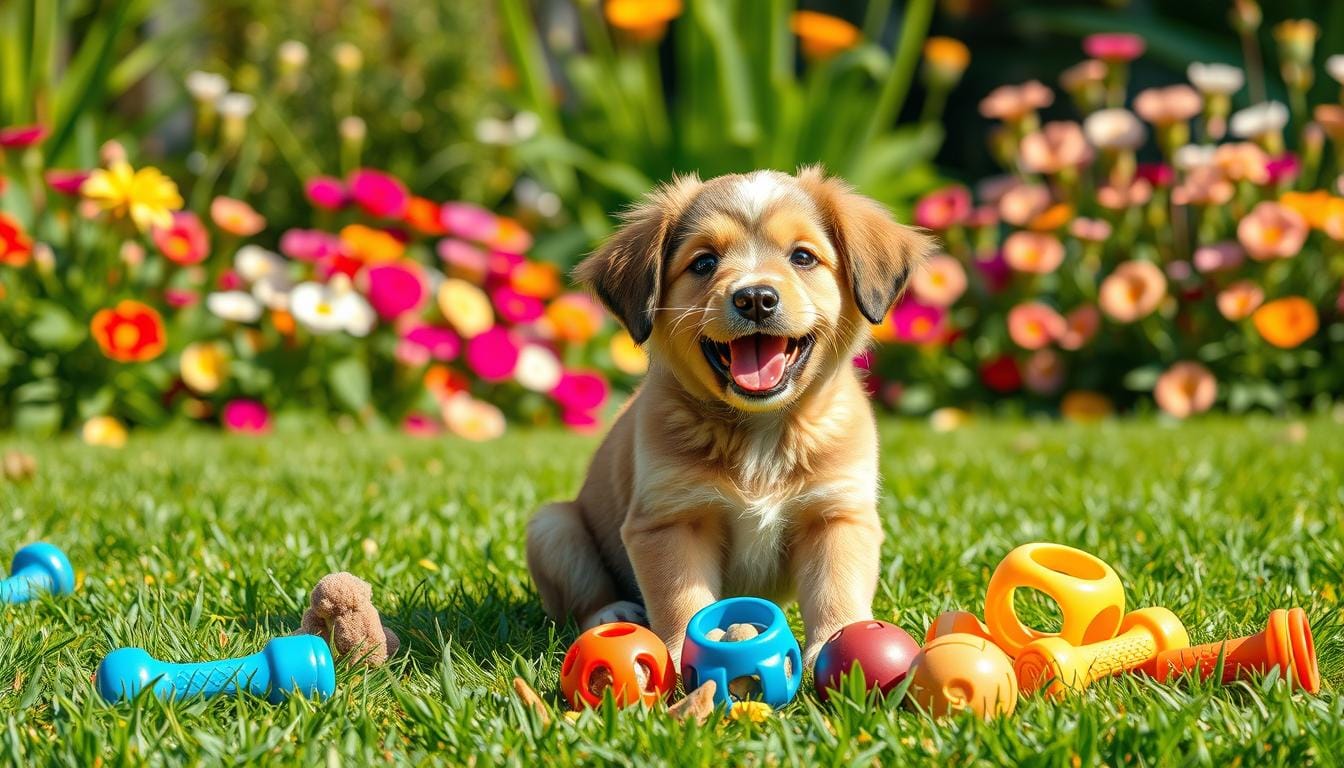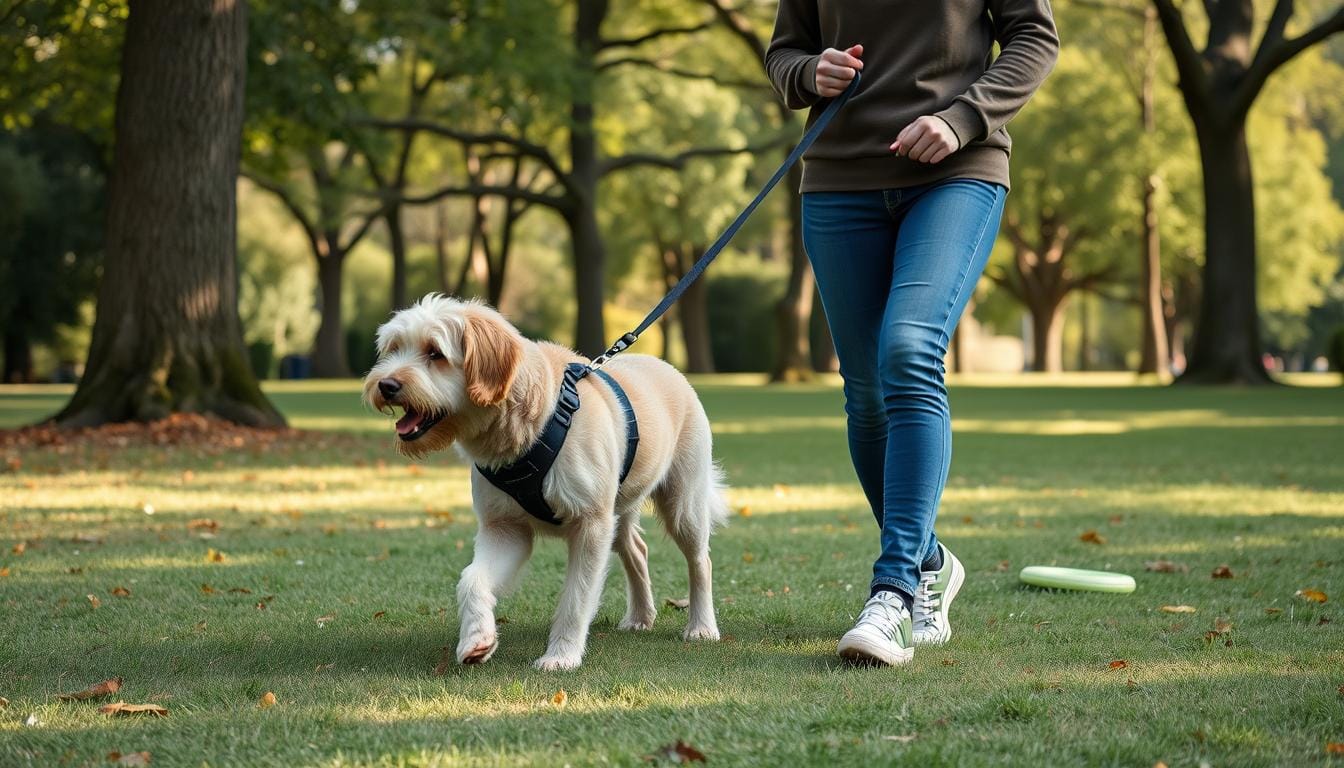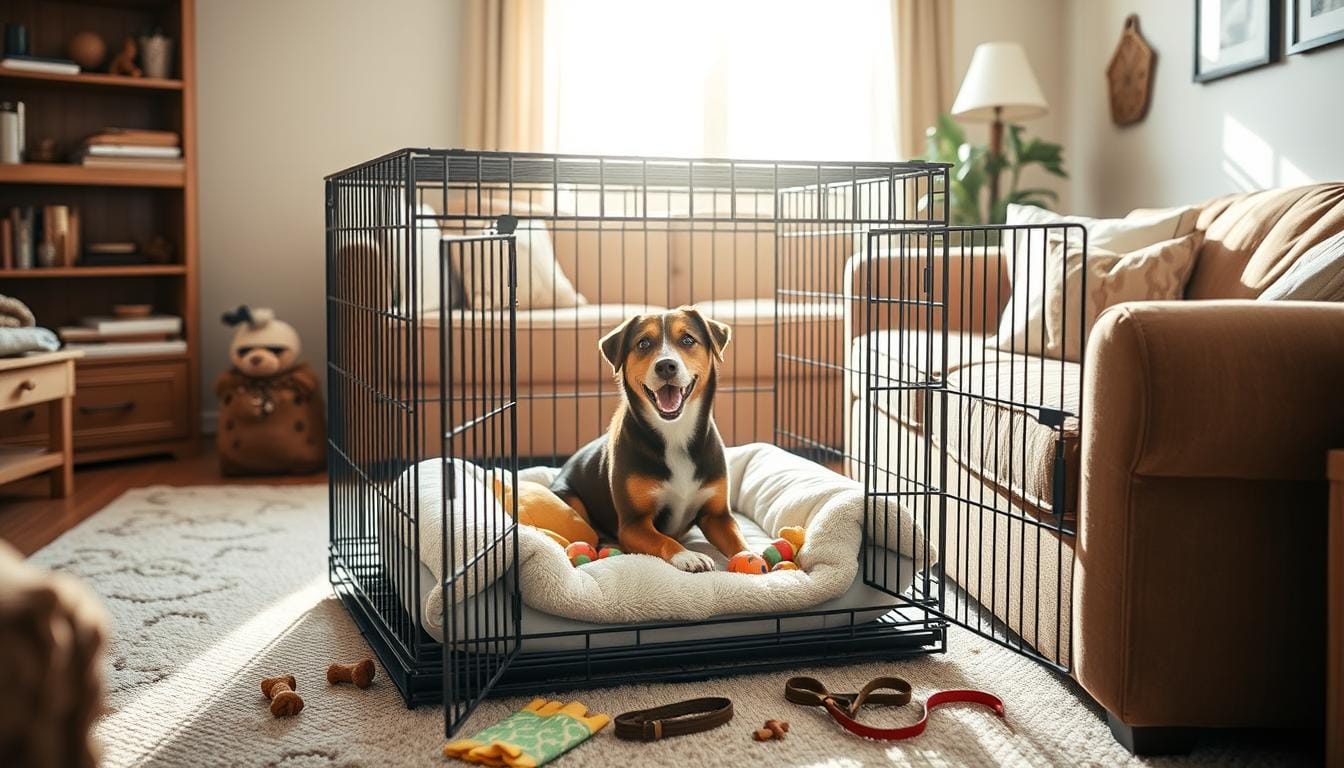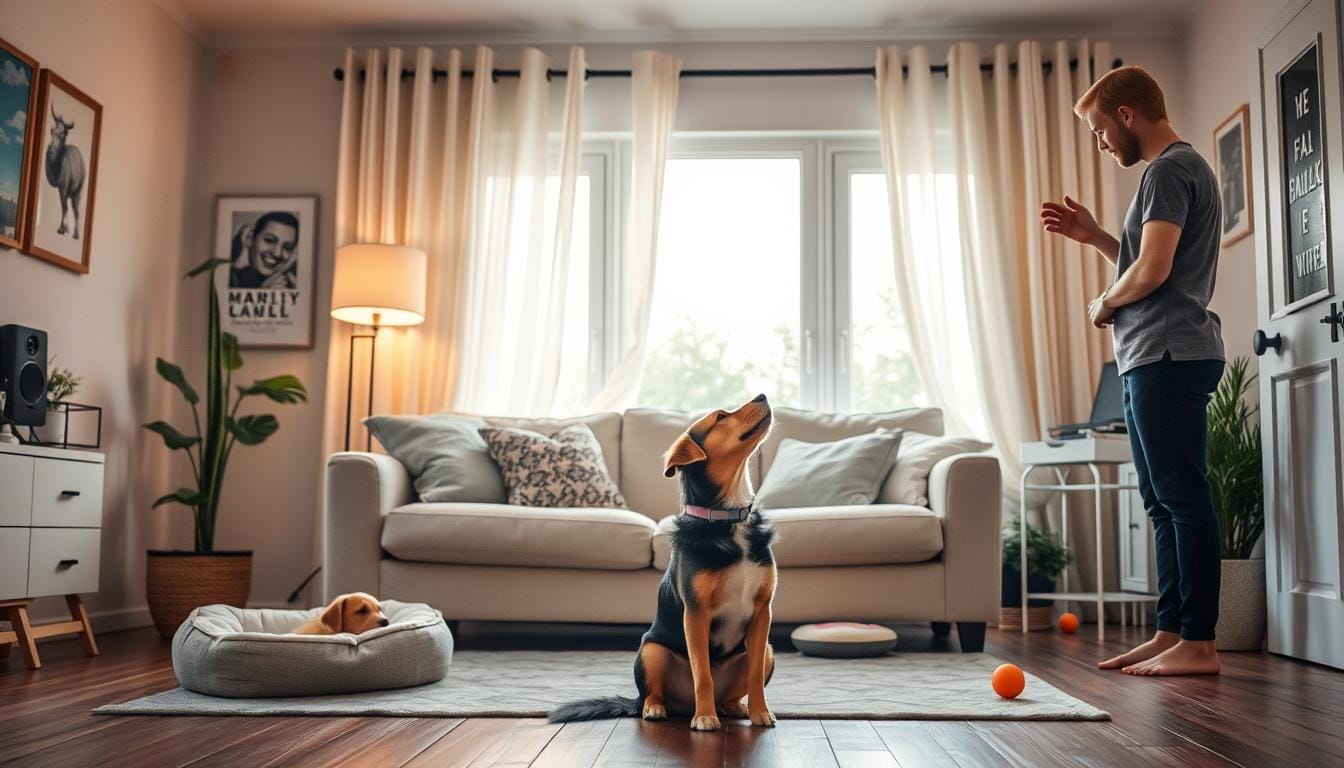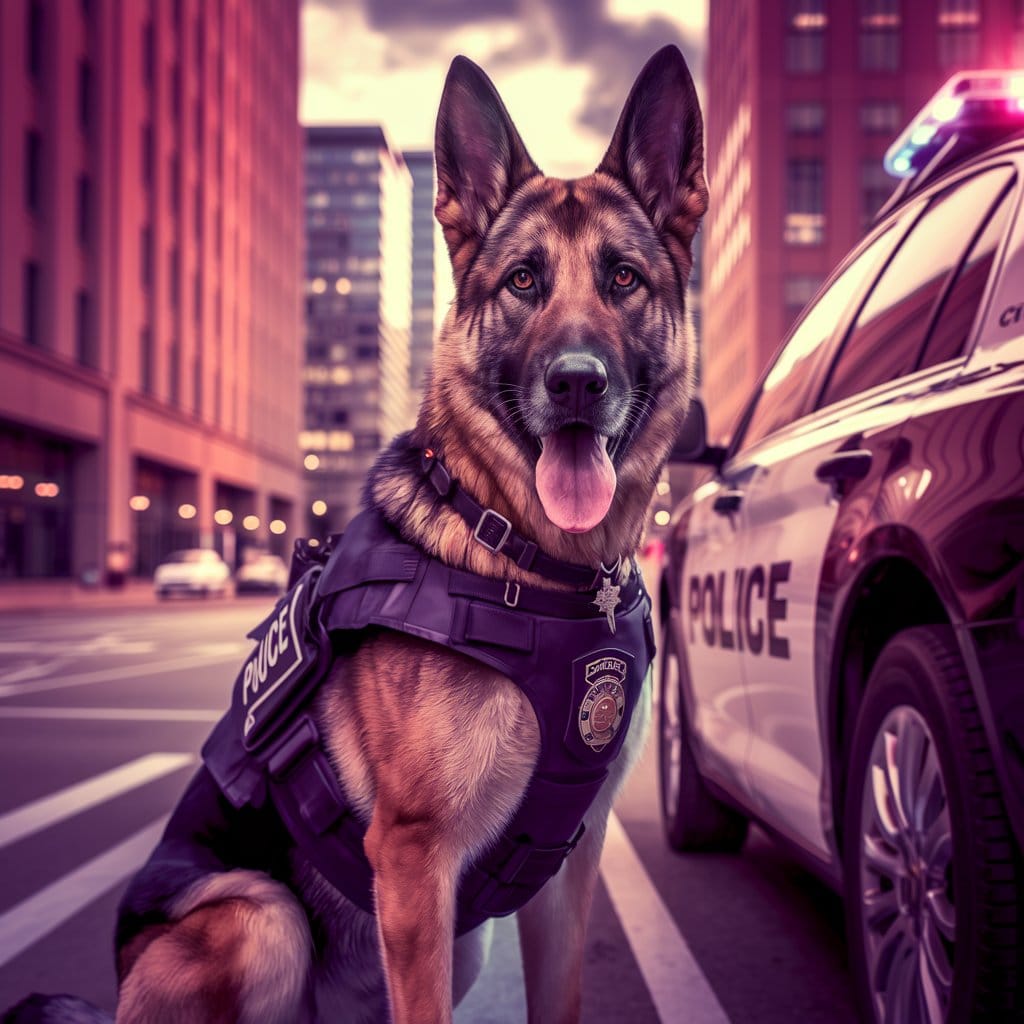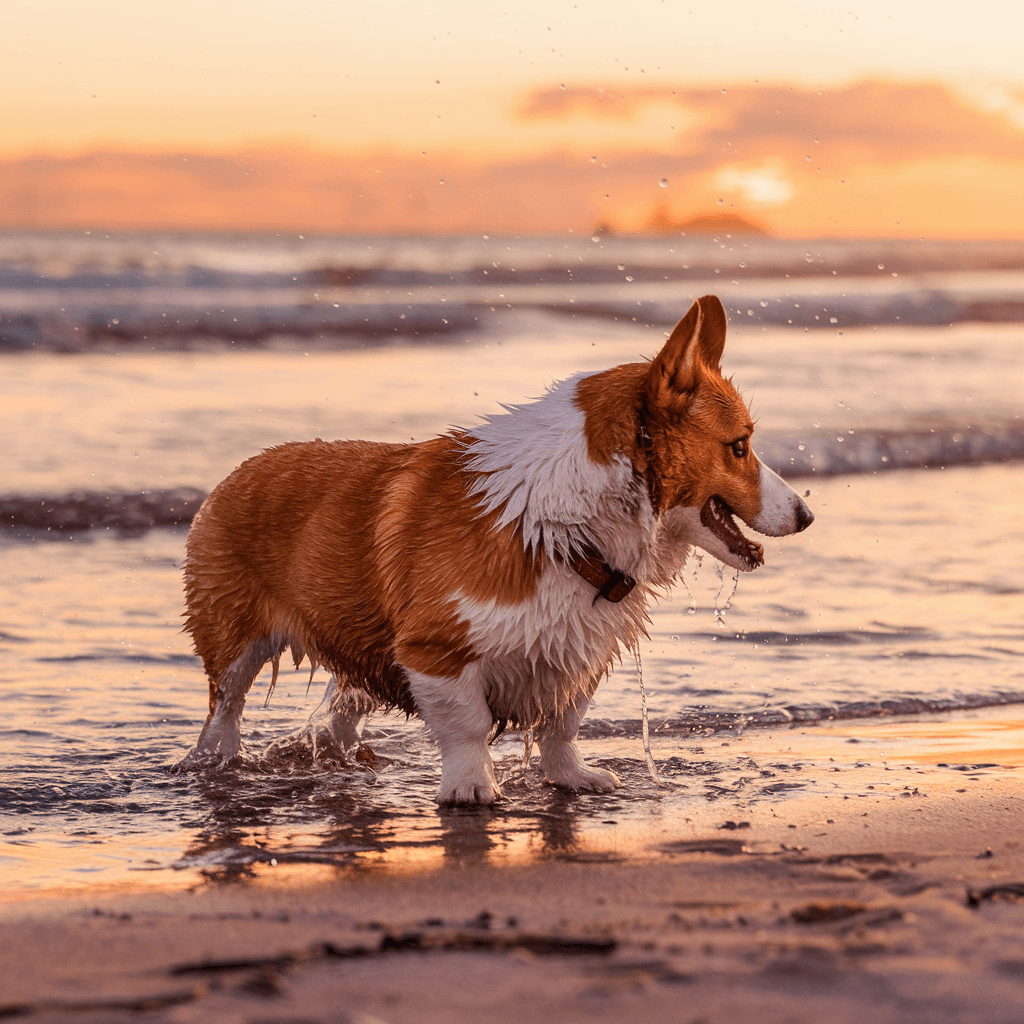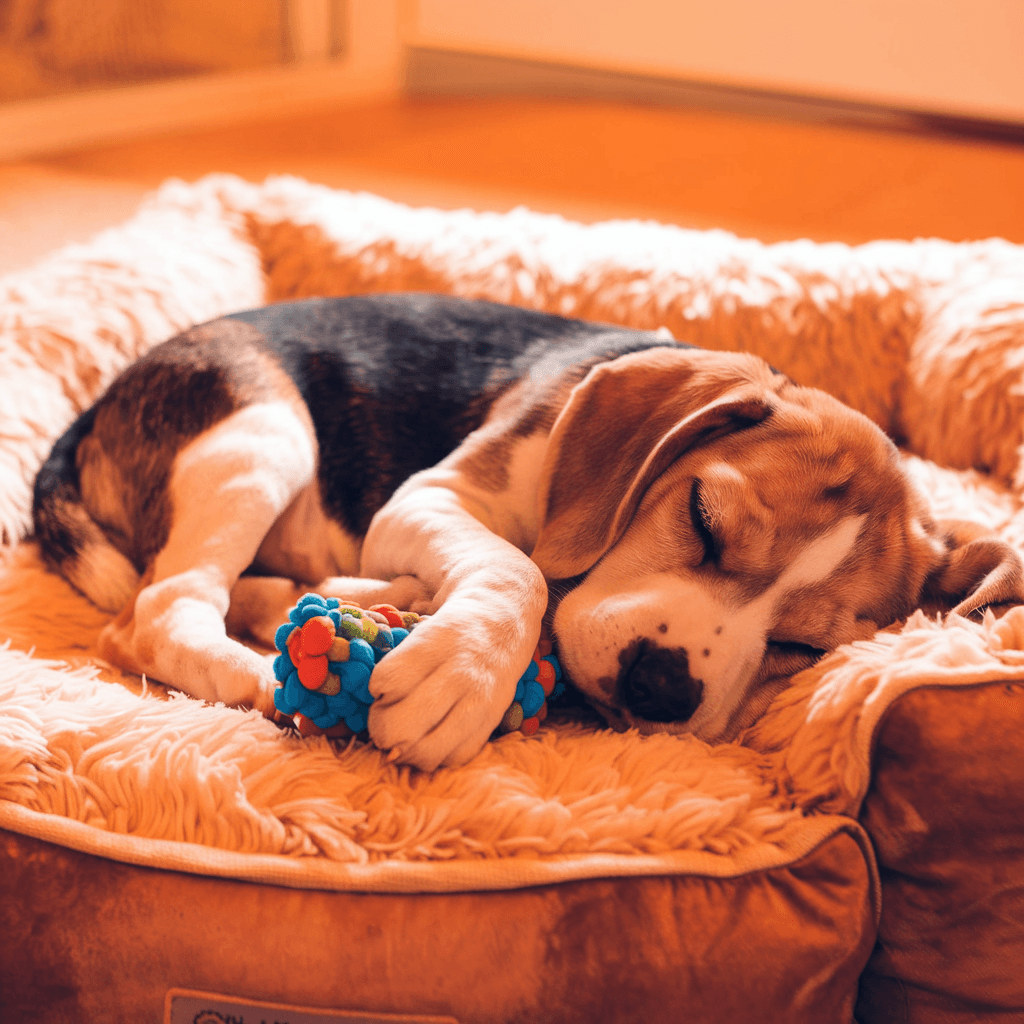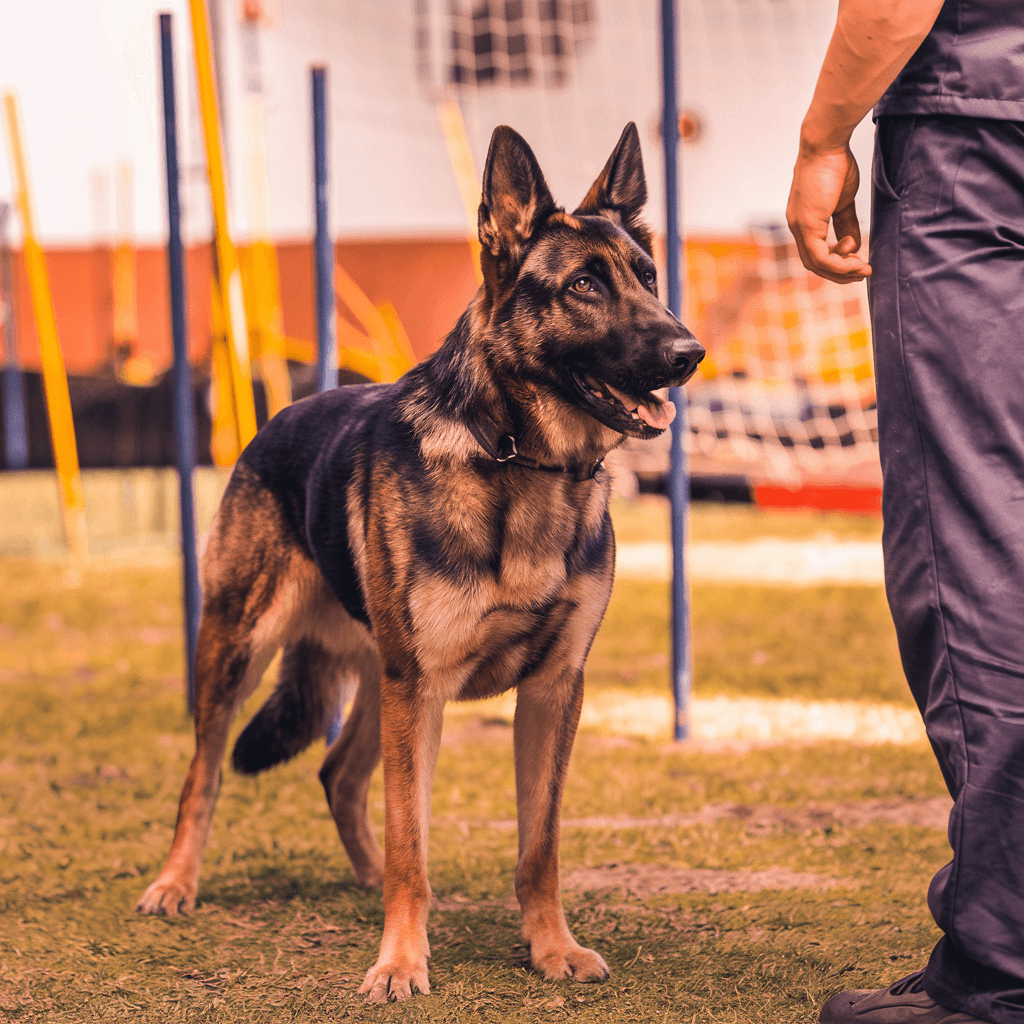Did you know dogs can sense human emotions instinctively? It’s true! Our canine companions can read our facial expressions and body language. They can even detect changes in our scent. This emotional intelligence is key to training a puppy effectively.
Puppies as young as 8 weeks old are ready to start learning. We set up a daily schedule for meals, potty trips, play times, and training. This structure helps them adjust to their new home and lays the groundwork for obedience.
In the early stages, we focus on crate and potty training. These skills are essential for more advanced commands later. We keep training sessions short and fun, using treats like Wellness Soft Puppy Bites to reward good behavior.
As we progress, we introduce the leash and teach basic commands like “sit.” Socialization is crucial, so we recommend puppy classes. These experiences help shape well-adjusted, confident dogs.
Ready to embark on this rewarding journey with your new best friend? Let’s dive deeper into the world of puppy training. Discover how to build an unbreakable bond with your furry companion.
Key Takeaways
- Puppies can start basic training at 8 weeks old
- Establish a daily schedule for meals, potty breaks, and training
- Focus on crate and potty training initially
- Keep training sessions short and fun
- Use high-value treats for rewards
- Enroll in puppy socialization classes
- Introduce leash training and basic commands like “sit”
Understanding the Importance of Puppy Training
Puppy training is key to raising a well-behaved dog. It’s not just about teaching tricks. It shapes your dog’s behavior for life. Let’s explore why puppy training is important and how it benefits you and your dog.
Building a Strong Foundation for Lifelong Behavior
Early training is crucial for your puppy’s future behavior. February is Dog Training Education Month, a great time to start! Training teaches dog behavior basics like impulse control.
Puppies learn to sit at doorways instead of rushing through. This obedience training prevents dangerous situations, like running into busy streets.
Enhancing the Human-Canine Bond
Training strengthens your bond with your puppy. A study found that puppy owners who attended classes used positive reinforcement more. This builds trust and eagerness to please.
Weekly live Q&A sessions on social media help new puppy parents. They address common training challenges.
Preventing Behavioral Issues in the Future
Proper training prevents unwanted behaviors. Research shows puppies in classes are less nervous or anxious when left alone. Socialization is crucial – puppies should meet at least 100 different people in their first month.
Classes also help puppies meet other dogs and experience new situations. This is important for their well-adjusted adult life.
“Positive methods used in puppy classes develop eagerness to please the owner and build a stronger bond.”
Remember, consistency and patience are vital in puppy training. It may take time, but the results are worth it for a lifetime of companionship with your well-behaved furry friend.
Getting Started: Essential Supplies for Puppy Training
Starting puppy training needs the right tools. We’ve made a list of must-haves for you and your puppy.

A crate that fits your puppy is key for housebreaking and safety. Add a comfy bed, elevated for those who prefer not to sleep on the floor. Also, get a leash and collar or harness for walks and training.
High-value treats are vital for positive feedback. Dental treats help keep your puppy’s teeth clean. Elevated dog bowls are good for feeding, as they ease neck strain as your puppy grows.
| Item | Purpose | Benefit |
|---|---|---|
| Reflective harness | Visibility during walks | Enhanced safety in low light |
| Training leash | Teaching heel and no-tug walking | Improved walk behavior |
| Puppy teething toys | Gum relief and occupation | Reduced destructive chewing |
Get different toys to keep your puppy’s mind active. The KONG Puppy dog toy is great for teething and can be filled with treats. Six KONGs, filled with frozen yogurt, pumpkin, and peanut butter, keep puppies busy for hours.
Puppy gates help with potty training by blocking off areas. Slow feeding bowls make meals longer, helping with digestion. Remember to have puppy-safe shampoo and a poop pail for cleaning up.
Creating a Positive Training Environment
A positive training environment is key to successful puppy training. We’ll explore how to set up the perfect space for your furry friend to learn and grow.
Choosing the Right Location for Training Sessions
Find a quiet, familiar spot for your puppy’s training. A place without distractions helps your pup focus better. As your puppy gets better, you can introduce more challenging places.
Establishing a Consistent Training Schedule
Set up a regular training routine with short, 10-minute sessions. This keeps your puppy’s attention and prevents frustration. Being consistent with cues and rewards is crucial for effective training. Don’t forget to take potty breaks before and after each session.
Setting Up a Reward System
Use positive reinforcement to encourage good behavior. Rewards can include treats, toys, or praise. FitBark GPS can help track your puppy’s activity levels during training. Keep these tips in mind:
- Use small, low-calorie treats
- Offer multiple treat options to prevent boredom
- Reward within seconds of the desired behavior
- Ignore bad behavior instead of punishing
By creating a positive training environment, you’ll see a 15% increase in your puppy’s motivation to learn. This approach builds a strong foundation for lifelong good behavior and strengthens your bond with your new furry friend.
How to Train a Puppy: Core Techniques and Approaches
Effective puppy training techniques are the base of dog obedience training. We start training puppies at 8 weeks old. We use positive reinforcement methods. This builds a strong bond and avoids confusion or fear.
Keep training sessions short, around 5 to 10 minutes. Puppies can’t focus for long, so short, fun sessions are best. Use high-value food treats to reward good behavior, making learning fun.

Consistency is crucial in puppy training. Use clear, specific cues for each behavior and stick to them. Practice in different places to help your puppy learn in various situations. This builds confidence and adaptability.
“Training should end on a positive note to keep the puppy engaged.”
Here’s a breakdown of essential commands and when to start teaching them:
| Command | Starting Age | Training Method |
|---|---|---|
| Eye Contact | 7-8 weeks | Capturing |
| Sit | 8 weeks | Capturing or Luring |
| Come | 8 weeks | Gradual Steps with Positive Reinforcement |
| Down | 8-10 weeks | Capturing and Hand Signals |
| Stay | 10-12 weeks | Gradual Duration and Distance Increase |
Remember, lifelong training is beneficial for most dogs. Active teaching continues until 2-3 years of age. Ongoing reinforcement is needed throughout their lives. By following these puppy training techniques, you’ll set a strong foundation for a well-behaved, happy adult dog.
Crate Training: Your Puppy’s Safe Haven
Crate training is key for housebreaking your puppy. It gives them a safe spot and helps them learn good habits. Let’s look at how to make crate training a positive experience for your puppy.
Selecting the Right Crate
Finding the right crate is crucial for training. It should let your puppy stand, turn, and lie down easily. Think about your puppy’s adult size when picking one.
| Crate Type | Benefits | Best For |
|---|---|---|
| Wire Crates | Good ventilation, easy to clean | Home use, larger breeds |
| Plastic Kennels | Durable, travel-friendly | Airline travel, small breeds |
| Soft-sided Crates | Lightweight, portable | Car travel, calm dogs |
Introducing Your Puppy to the Crate
Make the crate welcoming with soft bedding and toys. Use treats to get your puppy to go in on their own. Start with short times and increase it slowly. Never push your puppy into the crate or use it as punishment.
Using the Crate for Housebreaking
Crate training is great for housebreaking. Dogs don’t like to soil their sleeping area. Take your puppy out right after crate time for potty breaks. Remember, puppies under 6 months shouldn’t be crated for more than 3-4 hours at a time.
“Crate training can take days or weeks, depending on your dog’s age and temperament. Be patient and consistent for the best results.”
With proper crate training, you’ll give your puppy a safe space and help with housebreaking. Stay positive and patient for the best results.
Housebreaking 101: Teaching Your Puppy Where to Go
Teaching your puppy to go potty outside is a key part of raising a well-behaved dog. We’ll share some effective tips to make this process easier for you and your furry friend.
Creating a consistent routine is crucial for successful puppy potty training. Take your pup out in the morning, after meals, naps, and play. Remember, puppies need to go out every hour for each month of age.
Choose a specific cue word for when it’s time to go potty. This helps your puppy connect the word with the action. When they go outside, reward them with treats and praise. This positive feedback encourages them to go outside again.
Keep an eye on your puppy indoors. Watch for signs they need to go, like sniffing or circling. If you catch them, calmly take them outside. Clean up any accidents well to avoid them going back to the same spot.
“Consistency and patience are the keys to successful housebreaking. Every puppy learns at their own pace, so stay positive and celebrate small victories.”
For nighttime training, consider crate training. Puppies naturally avoid soiling their sleeping area, making a crate a great tool. Start with short crate times while you’re there.
| Puppy Age | Potty Break Frequency | Bladder Control |
|---|---|---|
| 2 months | Every 2 hours | 2 hours |
| 3 months | Every 3 hours | 3 hours |
| 4 months | Every 4 hours | 4 hours |
| 5 months | Every 5 hours | 5-6 hours |
Housebreaking takes time and patience. Stick to your routine, and your puppy will learn this important skill soon.
Leash Training: Mastering Walks Together
Leash training is key for every puppy. It’s not just about control; it’s about making walks fun for both you and your puppy. Let’s see how to make puppy walking a joy for everyone.
Introducing the Leash and Collar
Begin by letting your puppy get used to wearing a collar. Once they’re okay with it, add a light leash. Let them pull it around while you watch. This makes them think the leash is fun and freeing.
Teaching Loose Leash Walking
Teaching leash training needs patience and consistency. Use treats to make your puppy walk beside you. If they pull, stop. Start again only when the leash is loose. This shows them walking with you is a good thing.
- Keep training sessions short, about 10-15 minutes
- Use a 6-foot leash for optimal control
- Consider a front-clip harness for puppies prone to pulling
Addressing Common Leash Problems
Puppies often pull, lunge, or zigzag on walks. To fix this, change direction when they pull. Give treats and praise for calm behavior. Practice in different places to help them learn everywhere.
“Consistency is key in leash training. With patience and positive reinforcement, your puppy will soon be walking like a pro!”
Remember, leash training takes time. Stay positive, and soon you’ll enjoy stress-free walks with your well-behaved pup.
Socialization: Raising a Well-Adjusted Puppy
Puppy socialization is key to your dog’s behavior and personality. The American Veterinary Society of Animal Behavior says behavioral issues are the top cause of death in dogs under three. This shows how important socialization is for a happy, well-adjusted dog.
Start socializing your puppy between 3 and 14 weeks old. This time is crucial for positive experiences to shape their development. Introduce them to people, animals, and places to boost their confidence and social skills.
Joining puppy classes is a great way to socialize your dog. The AKC’s S.T.A.R. Puppy program helps puppies learn basic skills like accepting petting and wearing collars. These classes are a safe place for puppies to meet other dogs and people while learning important commands.
“Well-socialized dogs have a higher chance of being well-adjusted and confident, which can potentially save their lives in challenging situations.” – American Veterinary Society of Animal Behavior
To socialize your puppy well, expose them to:
- Different types of people (children, adults, men, women)
- Various environments (parks, stores, streets)
- Different surfaces and textures
- Common sounds (traffic, appliances, other animals)
Make sure each experience is positive with treats and praise. Let your puppy decide the pace and never force them. With patience and consistency, you’ll have a confident, well-socialized pup ready for the world.
| Socialization Period | Key Activities | Benefits |
|---|---|---|
| 3-14 weeks | Expose to various people, animals, environments | Builds confidence, prevents fear |
| 4-16 weeks | Enroll in puppy classes | Develops social skills, basic obedience |
| Ongoing | Gradually introduce new experiences | Maintains socialization, prevents regression |
Basic Obedience Commands Every Puppy Should Know
Teaching your puppy basic commands is key to raising a well-behaved dog. Puppies can start learning these commands as early as eight weeks old. Let’s look at some important commands and how to train them effectively.
Sit, Stay, and Come
The “sit” command is simple and a great first lesson. Use a treat to guide your puppy into sitting position. Reward them right away when they sit correctly. “Stay” is a step up, where you increase the distance and time they need to stay.
“Come” is crucial for your puppy’s safety. Make sure it’s always a positive experience for them.
Down and Leave It
To teach “down,” lure your puppy with a treat, moving it from their nose to the floor. “Leave it” helps keep your puppy from picking up dangerous items. Practice by showing two treats, rewarding them for ignoring one and taking the other.
Progressing to More Advanced Commands
Once your puppy knows the basics, you can move on to harder commands. “Heel” is important for safe walks, and “off” stops jumping. Consistency is crucial in training your puppy. Spend a few minutes, two to three times a day, practicing with positive reinforcement.
| Command | Difficulty Level | Key Training Tip |
|---|---|---|
| Sit | Easy | Use treat luring technique |
| Stay | Moderate | Gradually increase distance and duration |
| Come | Moderate | Always associate with positive experiences |
| Down | Moderate | Lure with treat from nose to floor |
| Leave It | Challenging | Practice with two treats, reward for ignoring one |
Addressing Common Puppy Behavior Issues
Puppy behavior problems can be tough for new pet owners. Dealing with chewing, biting, jumping, and barking can be frustrating. Let’s look at some effective ways to solve these issues.
Chewing is natural for puppies but can be destructive. When you see them chewing on furniture or shoes, redirect their attention to chew toys. This satisfies their chewing urge and protects your stuff.
Biting and nipping often come from play or teething. Teach them not to bite too hard by saying “ouch” firmly. This helps them learn boundaries, just like they do with their littermates.
Jumping up is a way puppies greet you. To stop it, ignore them when they jump. Only give attention when they have all four paws on the ground. Being consistent is important to teach them this.
Excessive barking can be fixed by finding what triggers it and teaching a “quiet” command. Reward them for being calm and redirect their attention when they bark too much.
| Behavior Issue | Training Solution |
|---|---|
| Chewing | Provide appropriate chew toys |
| Biting | Use “ouch” technique |
| Jumping | Reward “four on the floor” |
| Barking | Teach “quiet” command |
Consistency and positive reinforcement are key in solving puppy behavior problems. With patience and the right training, you’ll have a well-behaved pet.
Advanced Training: Beyond the Basics
Once your puppy knows basic obedience, it’s time for more. Advanced training keeps their mind sharp and strengthens your bond. Let’s explore ways to boost your dog’s skills.
Trick Training for Mental Stimulation
Trick training is great for your dog’s mind. You can teach them fun tricks like ringing a bell or recognizing their name. It’s perfect for high-energy dogs that need more mental play.
Introducing Agility and Sport Training
Canine sports are a fun way to exercise your dog’s body and mind. Agility courses, for example, are exciting for dogs and owners alike. They’re great for dogs that love to work and have a strong desire to please.
Continuing Education Throughout Your Dog’s Life
Training never stops. You can teach advanced behaviors like distance work or targeting objects. Some even train for pet therapy. Regular practice keeps your dog’s skills sharp. Joining classes or workshops keeps your bond strong.

